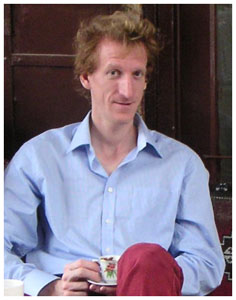PIMS Chats with Ben Green
Proofs in Prime
 Ben Green has always been drawn to math. Recalling his involvement in mathematical Olympiad competitions in high school, he says, “I think that’s when a lot of people realize they are interested in, and good at, mathematics. Once you make the realization that it’s possible to be paid to do mathematics, if you love doing it, then [becoming a mathematician] is really a very natural career choice.”
Ben Green has always been drawn to math. Recalling his involvement in mathematical Olympiad competitions in high school, he says, “I think that’s when a lot of people realize they are interested in, and good at, mathematics. Once you make the realization that it’s possible to be paid to do mathematics, if you love doing it, then [becoming a mathematician] is really a very natural career choice.”
In 2003, following the completion of his PhD at Cambridge University, he chose to come to PIMS as a post-doctoral fellow. “It’s a good idea to see different places mathematically, both for your CV and because it’s valuable to talk to different people.” PIMS and Vancouver seemed like a great opportunity to Green, he was able to enjoy the outdoors and learn to ski while developing his career. Recalling his time here he says, “It was a fantastic time, I did some of my very best work that year.”
Green wrote a number of papers during his time at PIMS, including one with Terence Tao of UCLA, which he considers to be among his most important work “The turning point in my career was the work I did while I was here at PIMS.” Their paper was on arithmetic progressions of prime numbers. While prime numbers have fascinated mathematicians for thousands of years and are extremely simple and natural to define, it is often very difficult or impossible to prove facts about them. “There are a lot of conjectures, but people don’t often succeed in actually proving anything about them,” says Green. In his paper with Tao, they proved that “any set consisting of a positive proportion of S contains arbitrarily long arithmetic progressions of primes [1].”
Green’s work now spans many diverse areas of mathematics, which he sees joined by a common thread of “finding structure in places where you wouldn’t expect it to exist.” Such findings, he explains, “are interesting in their own right and often have applications to other parts of mathematics”. This philosophy has provided him with many valuable lessons and experiences and has helped to shape his remarkable career.
Recalling his time as a first year PhD student he says, “I had the idea that I shouldn’t tell anybody about what I was working on because they would steal it… I was having a drink with a mathematician and he asked me what I was working on. I didn’t want to tell him, and he said ‘I may have been a bit like that when I was your age, but when you get to my age, you’ll be desperate for people to take an interest in things that you’re working on.’ And he was entirely right. Be open and talk to people about your ideas. The huge majority of mathematicians do not steal others’ ideas. If they do, they get a very bad reputation.”
For students thinking about pursuing a career in math, Green offers more advice, “The key is to work hard and keep an open mind. And don’t take it too seriously when someone questions the importance of a problem you are working on. Sometimes students come to me wanting to work on the Goldbach conjecture (an unsolved problem about prime numbers), which has been open for over 250 years. I have to break it to them that, to begin with at least, they need to work on something a little less notorious." Working on smaller, less significant problems, he explains, provides a means of getting used to the idea of thinking about mathematics and then developing techniques.
“I can certainly think of papers that I wrote early in my career (and indeed now) that people might ask why I cared, but I think 99% of mathematics is like that. But you keep working at it, because you can never tell which bits are going to turn out to be the really good stuff.”
Ben Green is the Herchel Smith Professor of Pure Mathematics at the University of Cambridge and a Fellow of Trinity College. He has published several important results in both combinatorics and number theory. These include improving the estimate by Jean Bourgain of the size of arithmetic progressions in sumsets, as well as a proof of the Cameron–Erdős conjecture on sum-free sets of natural numbers.
His work in demonstrating that every set of primes of positive relative upper density contains an arithmetic progression of length three then led to his breakthrough 2004 work with mathematician Terence Tao now known as the Green–Tao theorem.
On October 10, 2012, Ben Green delivered the PIMS Distinguished Colloquium lecture, On the Sylvester-Gallai Theorem, at the UBC site.
1 B. GREEN, Long Arithmetic Progressions of Primes PIMS Magazine 8:1, (2004), 10.